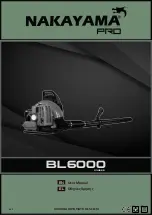
15
5.1 START-UP CHECKLIST
We recommend that these startup procedures be followed in sequence and checked off ( ) in the
boxes provided in any of the following cases:
• During initial installation
• After any shutdown period
• After maintenance work has been performed
• After blower has been moved to a new location
DATES CHECKED:
Check the unit for proper lubrication. Proper oil level cannot be over-emphasized.
Refer to the
Lubrication
section. Please see
Recommended Lubricants
for information
on acceptable lubricants for your product.
Check V-belt drive for proper belt alignment and tension.
Carefully turn the rotors by hand to be certain they do not bind.
WARNING
Disconnect power. Make certain power is off and locked out before touching
any rotating element of the blower, motor, or drive components.
“Bump” the unit with the motor to check rotation (counter-clockwise [CCW] when
facing shaft) and to be certain it turns freely and smoothly.
Start the unit and operate it for 30 minutes at no load. During this time, feel the
cylinder for hot spots. If minor hot spots occur, refer to the
Troubleshooting
chart.
Apply the load and observe the operation of the unit for one hour.
If minor malfunctions occur, discontinue operation and refer to the
Troubleshooting
chart.
5.2 STOPPING
CAUTION
Do not stop the blower if there are high outlet pressures in the outlet piping.
Unload the outlet piping prior to shutting down the blower.
5.3 PRESSURE RELIEF VALVE
Your Qube includes a pressure relief valve (or PRV) to prevent over-
pressurizing of the blower, silencer, check valve, and discharge piping.
The pressure relief valve is a high flow, reliable spring based piston
type with adjustable pressure rating.
The pressure relief valve will open any time the operating pressure
of the blower reaches the set pressure of the valve. It is important to
note that the opening of the relief valve is an indication that something
is wrong in the downstream piping system, from a closed isolation
valve to a buildup of material in a discharge pipe, or some other type
of obstruction. If the valve opens, indicated by a popping sound and
the rush of air escaping, you should shut down your Qube immediately
and determine the cause of obstruction in the discharge piping. Do not
simply tighten the valve to the point that the valve stops making noise.
Figure 5 - Pressure Relief
Valve Detail
VALVE
ADJUSTMENT
STEM
FLOW
















































